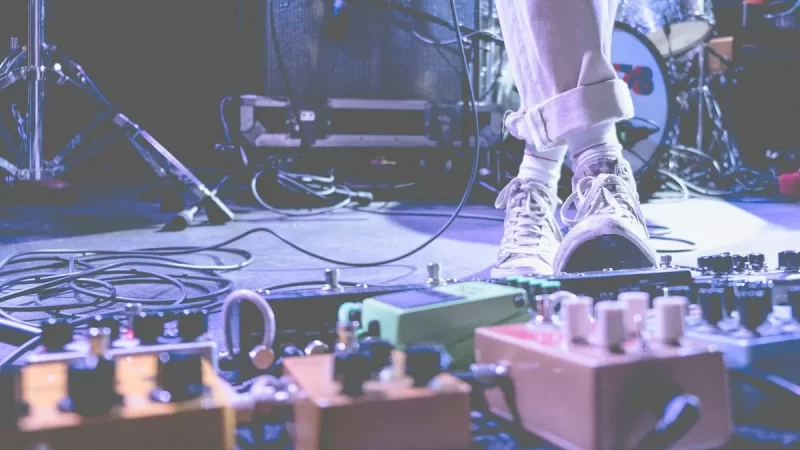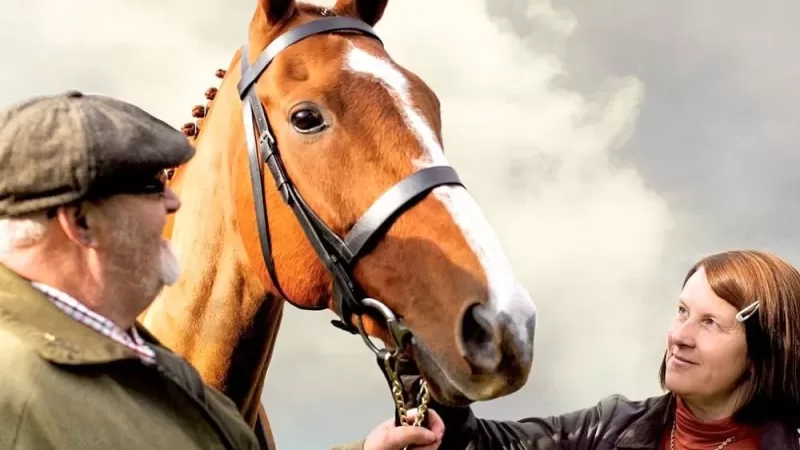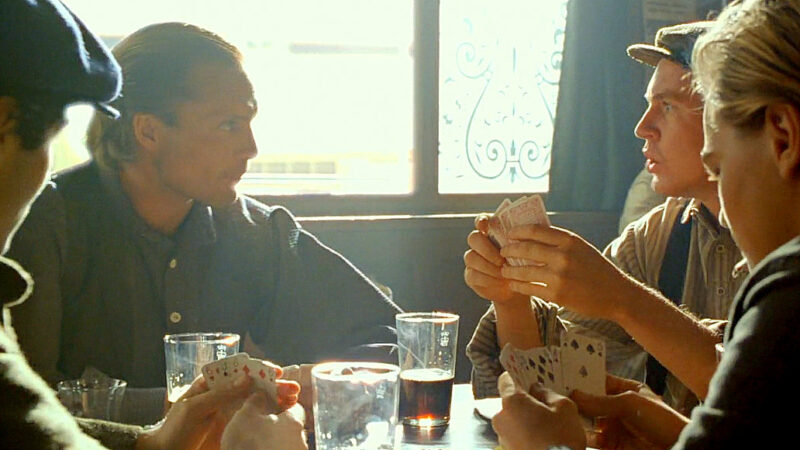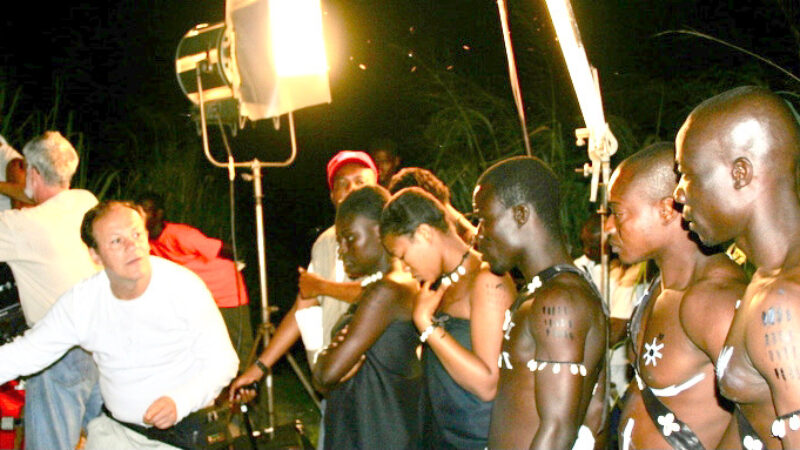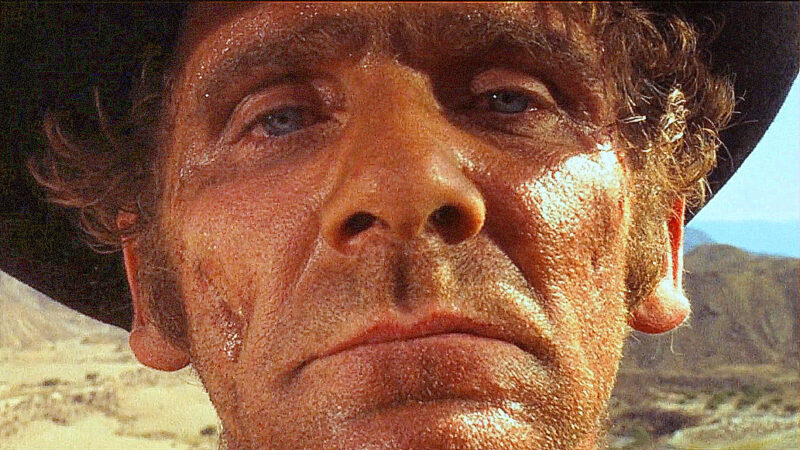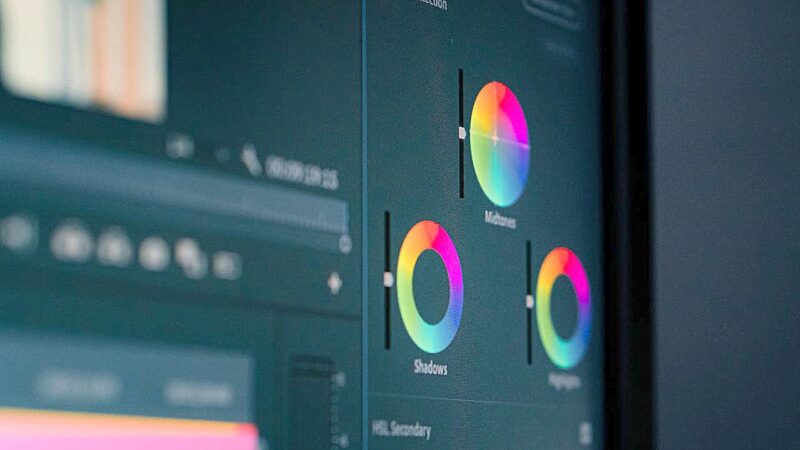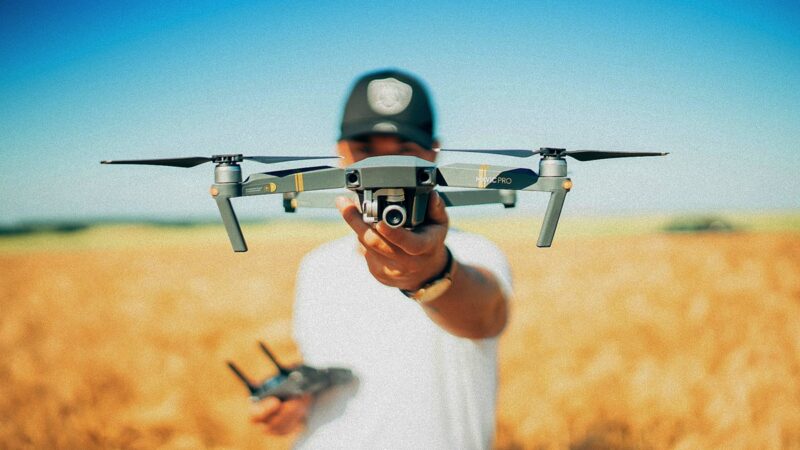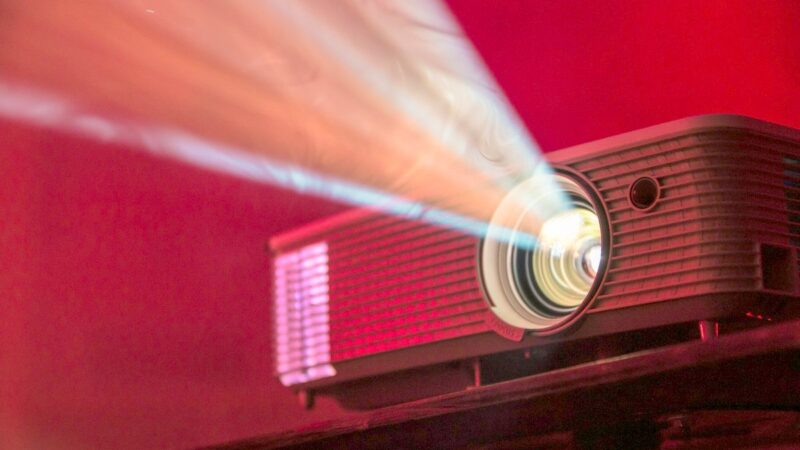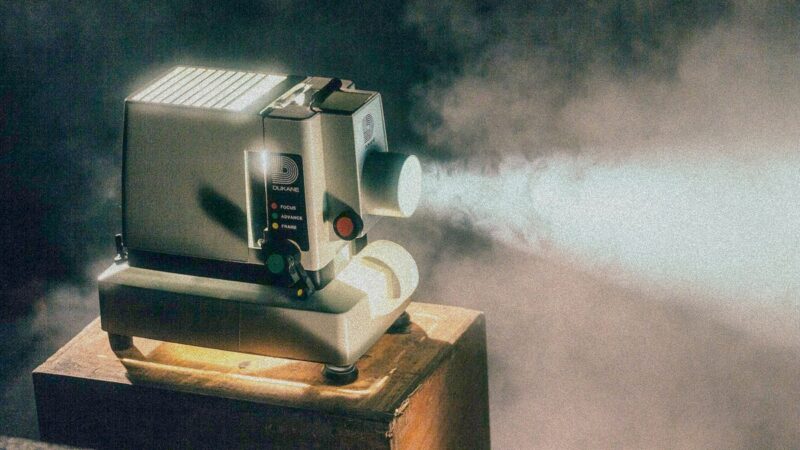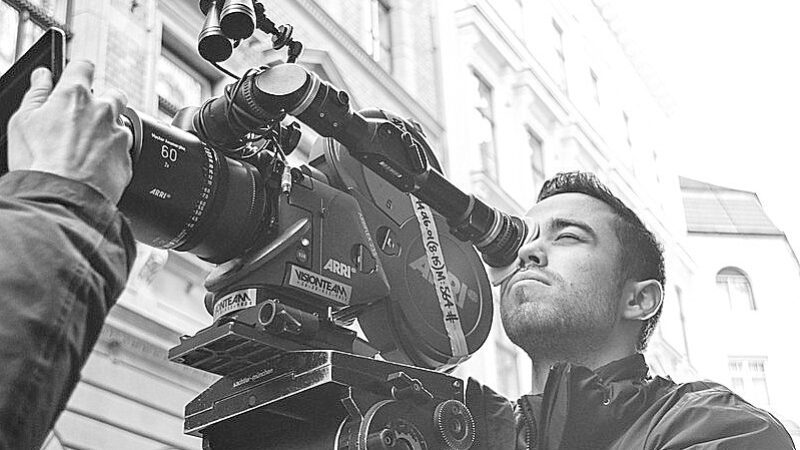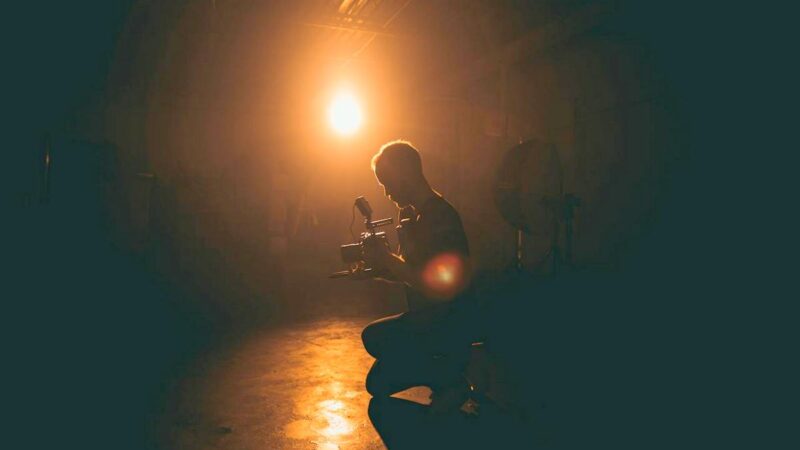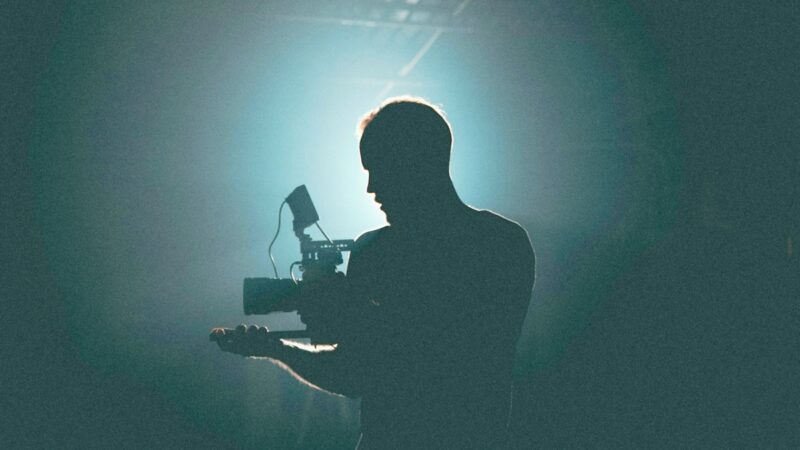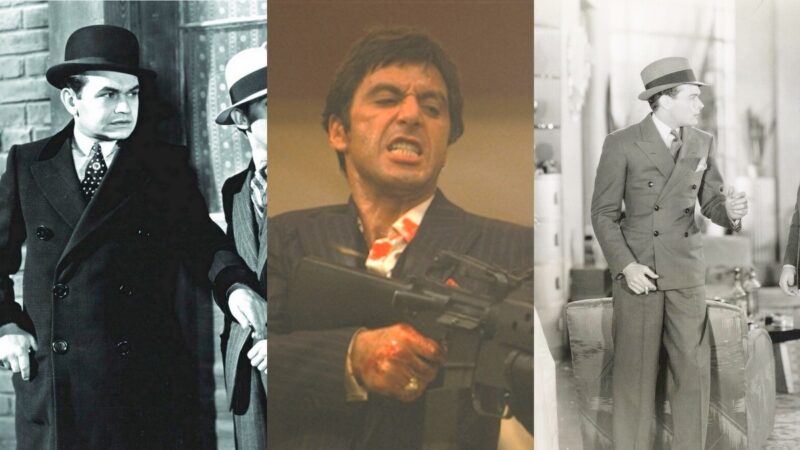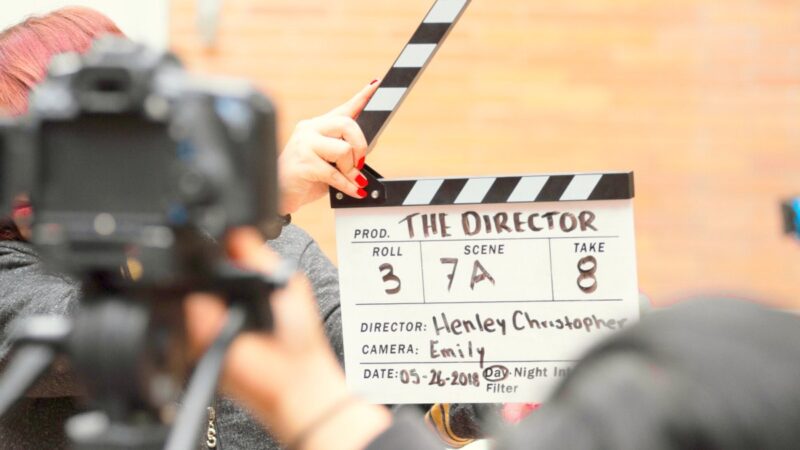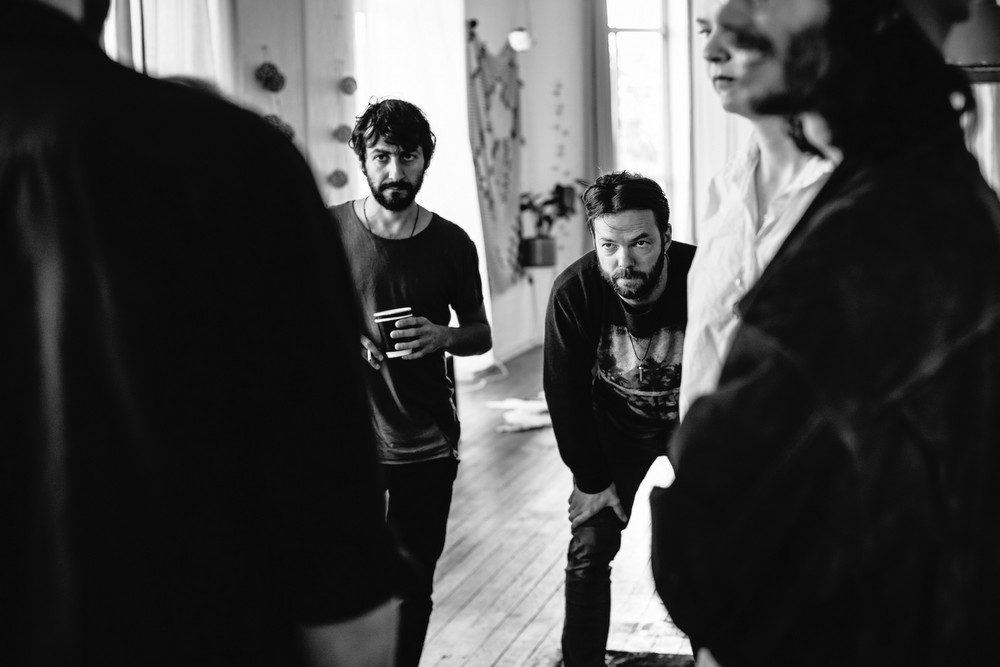
We discuss collaborative filmmaking with Director Mike Booth and DoP Burak Oguz Saguner on their upcoming independent Australian feature film Thirty-Three. Together, they talk us through their process of collaborative filmmaking in the making of Thirty-Three which is in its final stages of post-production.
indieactivity: Would you like to introduce your film, briefly?
Mike (Dir.): Our film is called Thirty-Three, and it’s a dinner party Drama. It’s a dinner-party where things go wrong. What’s the premise? Well, a woman, Saskia, is having her 33rd birthday, and she’s invited her friends, and her estranged brother shows up. And that puts a wedge in the proceedings, almost a domino effect. Plus, the other guests have problems of their own, and it all comes out as they drink and then move on to substances as well.
The tone is very, very realistic. We shot it as though the camera is like the invisible guest. Long shots, roaming fly-on-the-wall camera. The acting feels like it’s not even scripted. But it is; it’s very meticulously scripted. And it’s very relatable. It’s about real people going through real problems. Burak, would you like to add anything to your collaborative filmmaking? Or subtract anything?
Burak (DoP): Oh. I wouldn’t subtract anything. I would say it’s an adaptation of a theatre play, also called Thirty-Three, written and directed by Mike, and Alistair, his writing partner. I’d say it’s a very well adapted piece from theatre to film-a collaborative filmmaking success. Justice has been done to the story, due to its change of medium. The realism of it is impeccable. The conversation is natural.
It’s not pointing to a direction that the story needs to go to, but it allows the story to unfold, and flow into its trajectory. And, in terms of the shooting style, I’d say we employed long-takes rather than manipulated time with too much coverage. We’re very observational. That way the time’s real, it passes real, and everyone who is involved experiences it that way.
Mike: Yeah. I was gonna say, by not having coverage, by using long takes, it means we not only not manipulate time, but clearly not manipulating performance.
Burak: Exactly.
Mike: We’re not using the best bit from this piece, and the best bit from that. So, you can see what’s unfolding organically. Which gives it a greater sense of reality.
Burak: Yep. Exactly. It’s kind of like a well-scripted collaborative filmmaking documentary.
MIke: Yeah. My feeling is it’s kind of like a cross between Birdman and The Big Chill.
Burak(Pauses.): Yeah.
Mike: You know? If we had to pitch it, that’s what I would pitch it as. “Imagine The Big Chill… old friends getting together, oh, they got a history, oh, this is lovely, gonna play some tunes and do some dancing…! But it’s all one long shot. Like Birdman!” That’s the film. Chuckles.
Burak: That’s right.
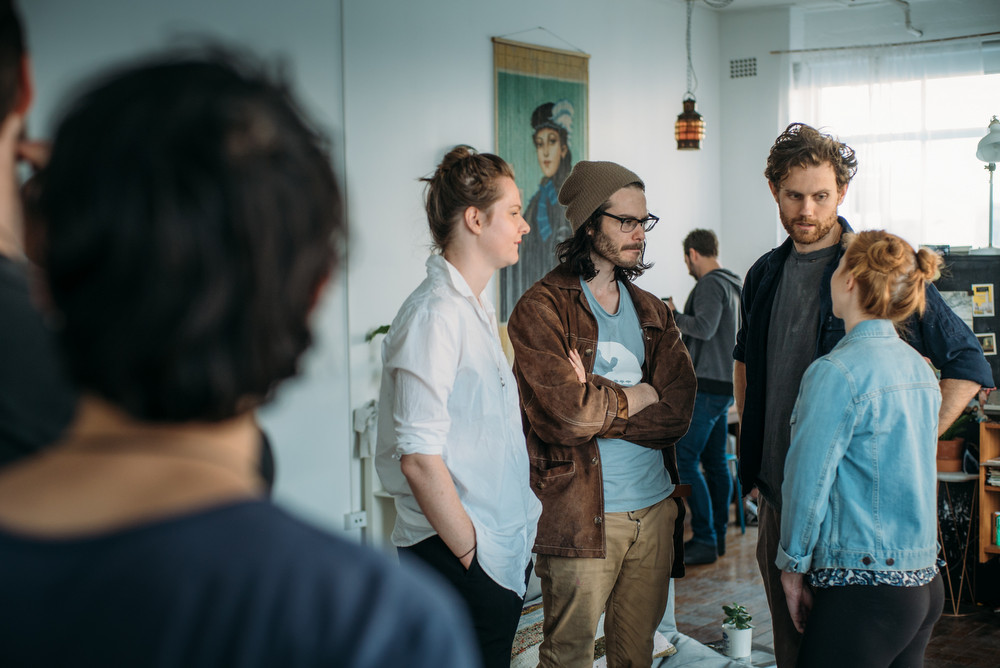
OK, Burak, what’s your personal experience with story, production, maybe even marketing?
Burak: I have known Michael from 15 ago. And, I wanted to collaborate with him during that time. We always talked about making a realistic, naturalistic piece. And then we worked on a feature film together early last year—Into the Waves. And, during that time Michael sent me the script of Thirty-Three—the theatre-play version. I read it, and I thought it was fantastic. So, from then we started talking about it and we became really close in collaborative filmmaking. Did some editing on the script in terms of how to visualize it.
Mike: We roomed together for a period of time, sharing my little dug-out dungeon in Darlinghurst. Apologies for the alliteration. And that made the process, I think for several weeks in pre-production, a full-time job—living and breathing it. And knowing we were employing the long takes meant that we… there was no editing. So, all the editing really, really had to happen before we shot. That’s true collaborative filmmaking. So that was a big part of the process. You don’t expect to be sitting down with the script cutting dialogue with your cinematographer. But it was a very enjoyable experience.
Burak: Yeah. It was.
Mike: It made you look that much closer at each moment, just off the page and imagine it.
Burak: Yeah. Exactly. And it works in every sense. I mean, you know, visualizing the film, the words. I mean, this script is a conversation piece also. It’s not just a party piece, but the conversation tells the story. So, I mean, you know, all those sentences mean something, and to find the meaning in terms of story and in terms of visual before you shoot, before you roll the cameras. I think our five weeks every day ended up being very fruitful collaborative filmmaking. That’s because we have to shoot it for five days only for a 90-minute piece.
Mike: Yes.
Burak: That’s how it’s done.
MIke: Could you tell us a bit about the role playing?
Burak Oh yeah! Yeah, we did the role play, didn’t we? I mean, I had to pick you up!
Mike: Yeah. So, whether it was after a rehearsal—because we were living together—or even at night between shoot days, we’d tend to go over a moment, or a scene in the film, and act out the parts of the moment. And yes, you, Burak, were Tim in one particular role play, and I was Maya, and yes you picked me up, as Tim does to Maya, just to see how it’s done. Just to know whatever problems our actors are facing, that we’ve been there, that we’ve tried it out and we’ve found a solution or we understand why there isn’t a solution and we don’t blame them, we go “Ooh, this is challenging.” But, we usually found a solution. (Chuckles).
Burak: That’s right. Otherwise it ended up being… This is actually perfect. This is what it means. Actually we don’t need to see for anything. It’s happening the way that it is. Basically, we lived and ate and drank this film, this story, in our time.
Mike: Yes, indeed.
Burak: I particularly enjoyed Lachlan and Josh role plays.
Mike: Oh, yes!
Burak: They were fantastic.
Mike: Yeah, that was probably one of the trickier dramatic moments in collaborative filmmaking to work through with the actors, because, it could read one way, and they had done it on stage a different way. That was a key moment that on stage that was quite physically aggressive, and it was your suggestion that that moment could be with no aggression at all, and it’s all about the tension as a stand-off, face to face. And so we worked to achieve that. And I’m pretty happy with the result that we’ve got.
Burak: That was a good way of employing and realizing that the frame is tighter and the details are much more closer to the audience, so it’s the difference in between stage and film—you can employ subtleties much easier when you make it a film, a stage play into a film. So, I think we played with the subtlety very well there, rather than having an explosion that is way too loud.
Mike: Oh, for sure. And then the explosions that happen still in the film are really wonderful.
Burak: Exactly.
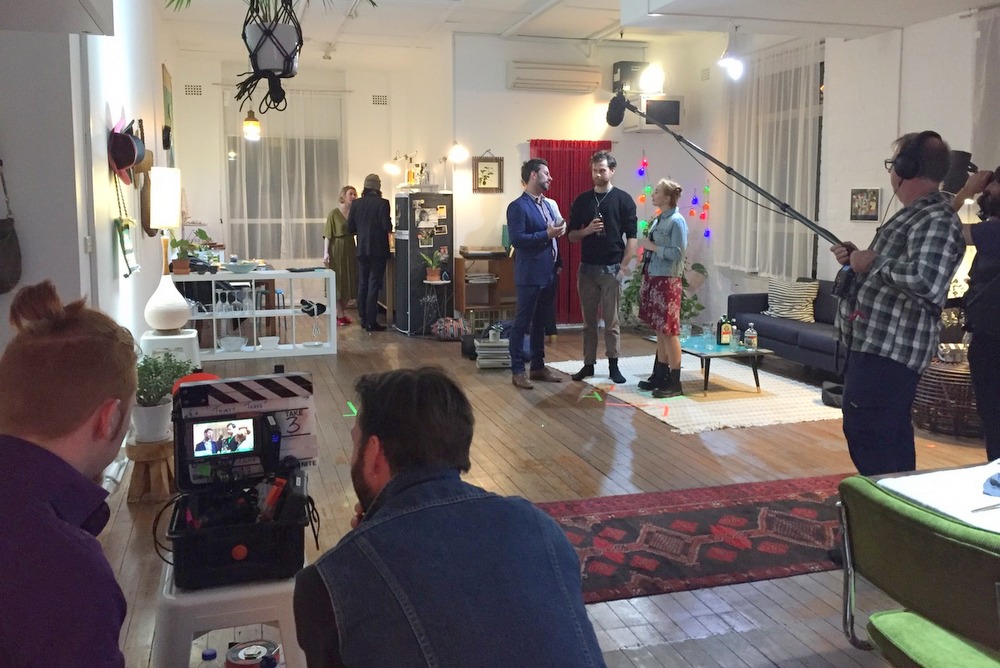
Did you start writing with a cast in mind?
Mike: Absolutely. This was written for the original cast, and in fact was developed somewhat through their input. Alistair I believe had the original idea: let’s make a play set in one room in one night with these people. There we six of us. So, alright, we’ll have six characters. Because we’d all done a play before that—That Old Chestnut. Although Ben wasn’t involved; Ben’s an old friend of Alistair’s, and so the role of Lachlan ended up being written for him. I could go into collaborative filmmaking detail of the mechanics of how we did that, but let’s just say the roles were all written and devised initially by the original cast from 2011.
Burak: You guys had a good sort of collaboration in terms of facilitating the actors in creation of characters as well. No?
Mike: Yeah. It was more about creating the relationships! When it comes to collaborative filmmaking or asking an actor to create a character, or even, when I as a writer try to create a character I go. Oh no. Certainly, I wouldn’t ask an actor to create a character, because, I just feel like that would go into a potential generalization, or something. But, certainly for the actors to come back and tell us about their relationship to the other characters. Alright, so you’re all best friends here. What’s your relationship with this person? Oh, you’re brother and sister. Well, how do you feel about them? What do you want? And so that relationship to the other character would then create the drive and the action for the night. What do you want on this night? Who do you want to speak to? Who do you have a beef with? Et cetera. So that there’s a lot of action happening.
Burak: That makes the story being read very tight.
Mike: That’s right. Well, my little assignment to the cast was: Give me your two wants—your conscious and your subconscious want—for each of the other 5 characters. So, their homework was to come back with 10 desires. And, there were 6 of them, so we had sixty desires running across back and bouncing off each other. It was quite mathematical. And, then you set up the premise, and then, you let it all unfold kind of organically, and the play writes itself. Sort of. That’s how I remember it—it’s a long time ago
How long did it take to complete the script?
Mike: Ah, yeah. Not long. So, Alistair wrote that first draft based on all that material that we got. And, then I picked it up, the second draft, probably… And he only had a week or two weeks to pump out the first draft. He likes to write quickly. I think given collaborative filmmaking, we had a very workable piece in a matter of six weeks. And before going into rehearsal I remember an intense two weeks to take it from, I think what you’d call the third draft into a rehearsal script. Working around my other job, so I was just doing mornings, starting at 5am and working till 11am. Get it done, feel good. Go to work, get an early night and do it again. It was a good process. I should do it again sometime. ‘Cause come think of it… Well, we wrote a play the following year, but that’s the last thing we ever wrote. (Laughs.)
Burak: Now we’ll be…
Mike: That’s right. Now we’re just adapting the same shit that we worked on all those years ago.
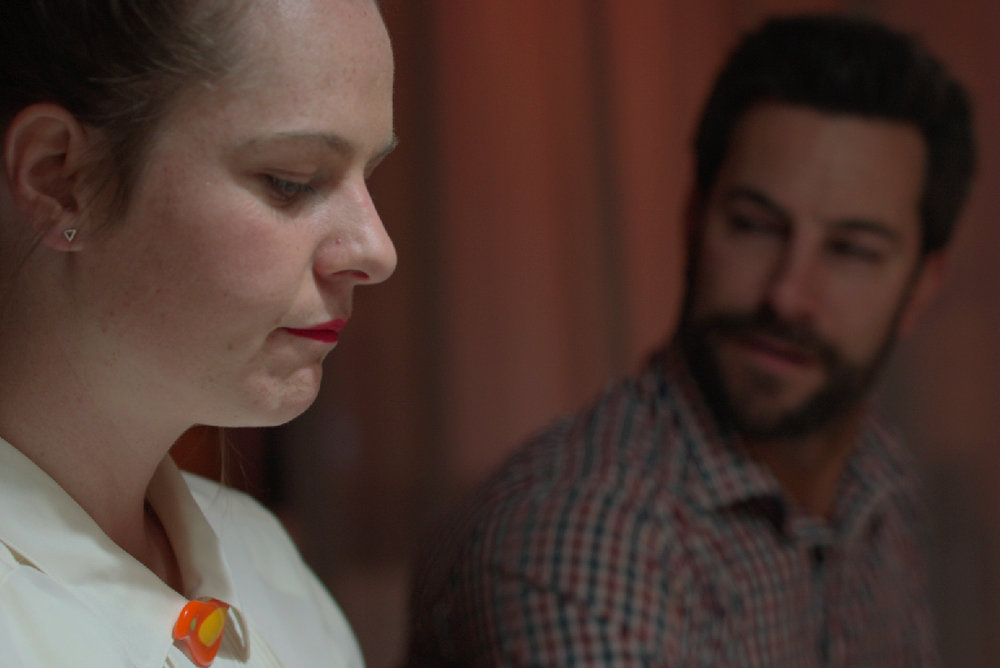
How did you develop your film?
Mike: Well, that was our conversations about what’s the point of view, where to put the camera—I think that is the initial germ of adapting during collaborative filmmaking. I think the main experience that Thirty-Three the play had for an audience was how real and upfront, up close and personal it was. It’s fly on the wall, and it could be quite excruciating how visceral and palpable the drama is. So how to translate that on screen without manipulating anything led us to develop this single roaming long continuous-shot camera work.
Burak: Yeah. We also thought of, I think, in its development, we thought of, if you’re not cutting it down, I mean, an audience in a theatre room don’t have added points reminding them that they are watching something that is fabricated. That’s a part of the development or collaborative filmmaking process or the thought behind what we ended up having for the style as well. So, if you’re not coming out of it going, “Oh, that passed, now we’re onto something else,” but you allow to watch the drama unfold in its own time, and to be able to observe, then you’re much closer to watching it like you would feel you’re in a theatre watching a play. And also you’re much closer to real life because people’s conversations don’t get edited and that’s why things get messy, like it does in Thirty-Three.
Mike: And, we wanted the flavor of it to feel like a documentary. It’s written to be naturalistic. The original play script, and original play production, we technically did not have a director. And I’ve always been a fan of theatre feeling really loose, a little bit chaotic. Because the party is chaotic. Any kind of polish and sheen takes me out generally. It puts me in a different emotion. It puts me in the emotion of, “Oh, I’m impressed rather than I’m moved or swept away”. So, we kind of replicated that. The film has a real looseness to it, despite it being meticulously planned and choreographed, so, much so that it should all feel accidental. And, given the nature of the way that we shot it in only 5 days, a lot of it is accidental. But only in the micro-moments. But not in the major moments.
Burak: No. No. I mean, the thought, the thread behind the way it turns out is completely well thought.
Mike: Yes.
Burak: Like if you were in a room, if you were the invisible guest to a party, you would not know what’s gonna come next. You try to catch up, and that’s what we’re trying to do. When we are following the actors and conversation we don’t know actually what we should be listening. It’s only the moments bring us to that conversation and takes us away from that conversation to the other.
Mike: I learnt a bit about collaborative filmmaking watching the Ken Loach’s film Land and Freedom. I’ll never forget—I must have been 19 or 20, maybe. And, there’s that scene where there’s the big town meeting, there’s maybe 80 people in a room having a debate. It was so realistic. And when someone would shout and start interrupting, the camera wouldn’t cut to that person for seconds later. It’s probably a basic editor’s technique to cut the visual after the sound. And what it taught me was that whenever a camera cuts to somebody who then conveniently happens to speak you get that sense, “Oh well they knew they were gonna speak.” (Chuckles.) Everything’s designed. So by… What you’re saying is by removing that sense, it takes the predictability out of it.
Burak: Exactly.
Mike: If that makes sense.
Burak: Yeah, we had a pretty good long rehearsal time as well, in terms of the development of the film. I mean, we did not do paperwork and mathematically time stuff. Instead, we worked all together as a collaborative filmmaking team—actors and the creatives—to really have a feel of these moments that we eventually see in the film. Rather than pre-empting them, we experienced them before the film got recorded, and all that had to be done was to just put it on tape…
Mike: Yep. Yeah.
Burak: ..and let it unfold.
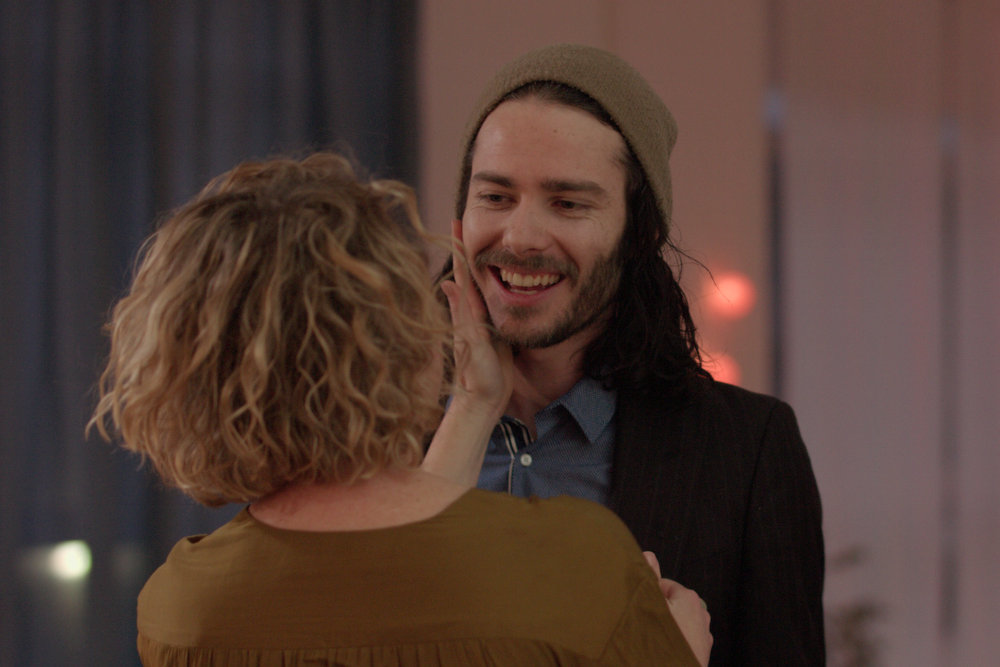
indieactivity: How was it financed?
Burak: Is it financed? (Laughs) Really?
Mike: I believe we had a, what’s called… Is it a “below the line” budget?
Burak: Yes, it’s a “below the line” budget. It wouldn’t be considered a budget.
Mike: We spent about $8k to get the thing in the can. That money came from some indiegogo crowdfunding and some generous friends and family, and then a little fundraiser from screening another film… (chuckles) ..that I made, helped a bit. And that’s how it was financed. And everyone worked with… quote-unquote, deferred payments. They laugh. It is all collaborative filmmaking. But, we work with people we know. And so they’ll do wonderful things because they love you.
Burak: Yeah, it’s a long gathering of talent and good souls.
Mike: Yeah. Yeah. It just reminds me… This is a slight segue. If I had any advice. I was thinking if I had any advice for filmmakers, I’d say, yeah, develop collaborative filmmaking based on two things: good taste and good friends who are very very talented. Just do those two things and… Well, I’m sure there’s more, but… yep.
Burak: That’s a good foundation.
Mike: Definitely good taste.
Burak: Definitely good taste.
Mike: I mean, we spend our time just watching films and knowing what we like. You know?
Burak: Yeah. And knowing why we like them.
Mike: Yeah. And what we don’t like.
indieactivity: Is there anything about collaborative filmmaking, you still struggle with?
Mike: (thinks): I feel at this point I’m still feeling like there’s gatekeepers. At this point. Well, because no-one knows who the hell we are. Well, relatively. Or who the hell I am. So I feel I have to get noticed, is one thing. Other than that I hope to stay independent. Independent. I like the actual meaning of the word. It means not dependent. Meaning you’re not relying on something else. And I’d like to not rely on anything else.
Burak: Mm-hmm.
Mike: What about you, sir?
Burak: Oh, man, I don’t think I’m struggling with it. I mean, independent filmmaking or collaborative filmmaking is good. I think I would struggle with people wanting certain things, because it would sell better and it would suit the marketing model better. That would be very much of a struggle. But, of course, I struggle with the idea of there’s always “big guns” and gatekeepers, as you put. And an uneven distribution of wealth in filmmaking, like everything else in the world. A bit more… A bit even resource distribution would I think help. Some ideas could come as fresh and experimental to find out new things, rather than repeating the successful films that made the box office.
I think movies need to become more interesting and more of an experience. We’ve been seeing the same stuff over and over again, in a general sense. So that’s maybe a struggle, in a general sense. Otherwise, independent collaborative filmmaking is wonderful. It’s not a struggle, it’s great. You’re free. If you want to be. And it allows you to be what you wanna be. That’s not a struggle. And it’s great doing things with less. That’s wonderful. Because you can never have enough.
Mike: I’ve been watching some Tony Gatlif films.
Burak: Yeah?
Mike: So I saw Vengo. You know Vengo?
Burak: Yep. I know all of his films, man.
Mike: You’re a fan?
Burak: I’m a fan.
Mike: Yeah, I’m a fan too.
Burak: And a beautiful soul he seems.
Mike: Yeah. I was just reading about how he deliberately prefers a smaller budget, because of the freedom, you know? There must be a tipping point where any more money and you’re just gonna have less control, or less freedom, and vice versa.
Burak: It’s very basic. If you want freedom you should be able to say no. The point where you can’t say no to be able to finish something is the point where you lose your freedom. And you don’t want to do that. I’m doing it for the art of collaborative filmmaking, so…
Mike: I think freedom in filmmaking means no-one is going to say, “You can’t do that.” I think that’s what the freedom we’re talking about means: that I’m gonna shoot it this way—no-one’s questioning that. We are free. And so when there’s money involved, even ourselves—it can be harder to take risk. They’re always calculated risks. But, yes, one can experiment when there’s less finances at stake. Which is the poin tof independent collaborative filmmaking.
Burak: Yeah. Also, man, the more you have the lazier you become, in terms of—I mean, we’re talking about this being a creative collaborative filmmaking process—and in order for it to be creative you need to have some sort of obstacle. Because you’ve gotta solve what’s coming your way. And not with throwing resource at it, but just genuinely asking the question what am I gonna do? Because the human brain’s a pretty powerful tool when that question is asked. And if you’re allowed to ask that, that’s when great stuff comes.
Mike: Yeah.
Burak: I mean, I can’t imagine this film being made for millions and then being constructed as a working process the way that we did. Everyone would love to see the proof of concept instead of us figuring out the way to how to make it right.
Mike: Well, I hate to say it but freedom’s just another word for nothing left to lose, man.
Burak: That’s right.
Mike: I believe that was Kris Kristofferson who said that.
Burak (laughs): Wonderful.
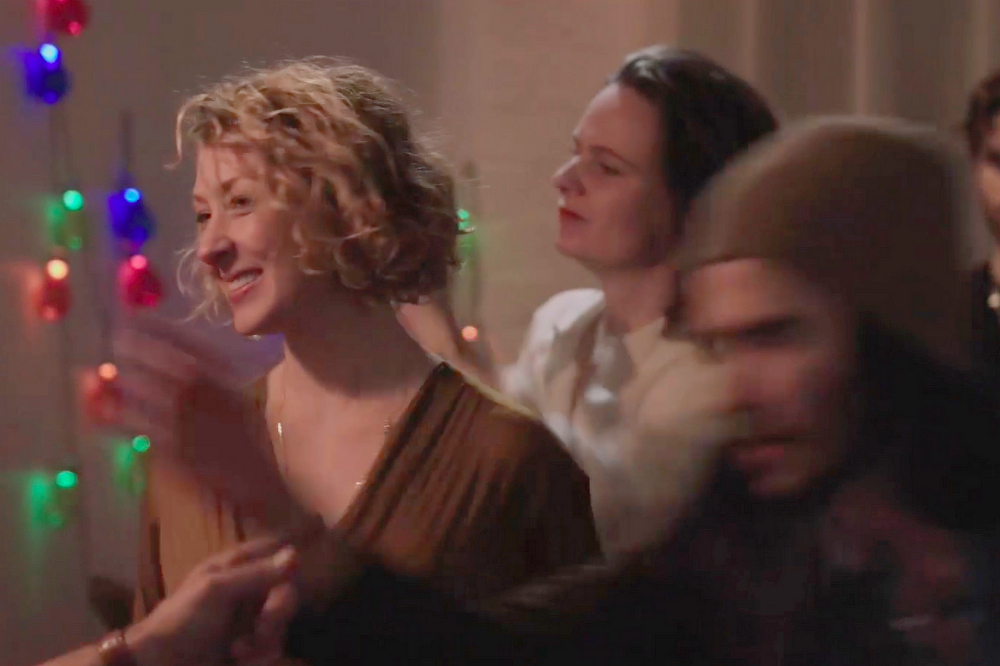
indieactivity: How long was pre-production?
Mike: (laughs)
Burak: How long is too long?
Mike: Pre-Production was… well, put it this way. We did it as a play in October 2016, we shot that as a feature film in August 2017. So that’s 10 months later, but it’s just after the play had closed a friend suggested “Hey, why don’t you shoot it as a film? Your cast are available and they know the thing. The iron is hot.” So, pre-production was going to be only a few weeks and then that fell through—that was aiming for December—basically due to people’s availabilities. One of the problems with independent collaborative filmmaking, particularly when you are not paying people, is that if they have planned to go away at a particular time you, kind of have to honor that.
Particularly around Christmas time. So, you make adjustments and you change the schedule and shoot it later, et cetera. Then, negotiating all that, and serendipity allowing that four months after, or three months after planning to make this film, the director, i.e. me, meets the cinematographer, i.e. you, by accident, like a reunion, doing an independent micro-budget feature film in Tasmania for three weeks, which sealed the deal, changed the ante. So, this little piece of “let’s make a film after doing the play” got a little bit more serious. So, preproduction, let’s comfortably say was six months.
Burak: Yeah.
Mike: Oh yeah, you shot the film in, I say four days now.
Burak: Yeah, the first the day was a recorded rehearsal, I would say. (laughs)
Mike: Yeah, and they weren’t long days! You go, “Oh, wow! What, you shot in four days? You must have been doing 24 days.” But no, strictly…
Burak: Under ten hours, easy?
Mike: Well, the call was 3pm and we wrapped usually no later than 11pm. So that’s still an eight-hour day. But we were not getting multiple setups in scenes to a schedule.
Burak: No, it was a very fluid way of shooting something without any of that bureaucracy getting in the way, so that helps. Resets take a lot of time in between takes.
Mike: Yeah, well given that one of our ideas was to shoot the entire thing in one ninety-minute continuous shot, certainly something that we were exploring, set us up that we would get a lot of stuff covered in a single night. And then it really just worked out. Well on night one we got this section in the can so on the second night we could focus on something else.
Burak: Well and other thing, this is another segue but, and another beautiful thing was that we only had one location which we had access to before we start shooting. So that allowed me to light the entire set before we start shooting. Once and for all. Given that it’s a naturalistic piece as well, so we’re not playing with the lights in between takes or from day to day. They remain as they are. And also, we got to see huge chunks of the film as we were watching the rushes, rather than trying to piece together individual shots, whether we had the story or not. So, it was very easy too look back at a thirty-minute section of the film and to be able to judge that is easy, because you are watching the film. You are not watching individual takes. And then going back and fixing the mistakes or the drops in the scene is easy because they are so identifiable.
Mike: Surprisingly, I remember maybe in a certain way, but how un-stressful it was.
Burak: (laughs) Yeah, it was very un-stressful considering what was at stake and what could go wrong. Mike: Yeah, what could go wrong? Things didn’t go wrong where we had not covered our arses. We were open to a lot of things going wrong that did not go wrong. Yeah, it was a very enjoyable shoot.
Burak: Yeah, it was definitely very enjoyable, one of the best I’d say from my experience.
Mike: I think the cast had a good time.
Burak: Yeah.
Did the tight-shooting schedule make it harder or easier? How did it affect performances?
Mike: Well, I would say it affects performances, shooting schedule is tight, because they’re long takes the pressure is on, you can’t drop out. You’ve got to stay in it. You got to trust accidents. I think it makes you trust more. It’s just all heightened. Given that we got what we wanted on each given night we didn’t need a longer schedule. It took four days to get what we needed, rather than trying to get what we needed in four days. Even though we only had four days. We didn’t have a choice.
Burak: That’s right.
Mike: But God was on our side (laughs)
Burak: (laughing) Exactly, nobody got a flu or cold on the third day. It would have been hard. But I mean also, I think doing it this way of course it effects in a positive way, the performances. I think for an actor it is very hard constantly being stopped in the middle of a scene and then asked to repeat that same emotion, repeat that same performance or heighten it or pull it down. When you let someone do their work in the time that requires then they are allowed to feel that they are this person, they can become consistent with the time.
Mike: One thing that we did special was, we shot that opening sequence through the course of sunset. So, every night of the shoot we rolled camera at the same time and shot the same scene which happened to be around half an hour along. It starts with sunlight coming through the window towards the dusk and by the end of the scene it’s nighttime. So that put the pressure on the cast, on everyone, that it’s now or never. Well, it’s now or tomorrow night same time, same channel, which is how it pretty much went, which is why we got it on the last night.
Burak: (laughs) Exactly.
Mike: But that heightens and you can see it in the film. Those actors are on edge, which I hope translates to how they are as the characters entering this party. So yeah, it’s documentary. It was not constructed.
How important is marketing? Do you think a project would make any dent without it these days?
Mike: Well I’m about to discover all that and I’m starting to appreciate that it is very important. Simply, because this is a little film, for people to know about it and have access—for there to be a strategy to get people interested. I’m starting to understand. But this is all what we’re about to learn, I think.
Burak: I mean, yeah marketing, it’s important. Making the film is more important than the marketing, I’d say. As far as I believe.
Mike: Is there an Academy award for the Best Marketing?
Burak: Probably not, but I think the best film means the best marketing, for most part. It seems so. There may be a subliminal thing going on there.
Mike: (laughs) Yeah, that’s interesting, because I wonder how people involved in marketing feel about that. Because they were part of that film and there is no category Best Marketing.
Burak: (laughs) No there is none.
Mike: And you know, I’d give the award to Blair Witch Project. That was some ingenious marketing. I’m only beginning to understand what the word actually means. And how it’s distinct. There’s marketing, there’s advertising, there’s sales and there’s one other Satanic thing. umm, I forget. But I appreciate marketing is about strategy and is about being creative to draw attention to the piece.
Burak: Exactly, I mean that’s my understanding of it. Marketing is important because a lot of people’s efforts go into making a film and the best celebration and best outcome, the best pay check that you can get out of a film you made is for it to be seen. And being able to hear the reaction that it gets from the audience. For that to happen it’s got to be marketed somehow. I think that’s the importance.
Mike: Yeah, and also it’s important to, in terms of marketing, thinking about “how we’re going to describe this? What’s the angle here? Is it the fact that it’s a low-budget film, is it the fact that it’s experimental or is the fact that it is about human, family relationships, that that’s the appeal? Yeah, I just started to think about demographic and, I don’t know… how to get people to see this thing?
Burak: Exactly.
MIke: I’m not the best example
Burak: (laughs)
MIke: Because it’s like “why do I watch films?” Because I like films. I don’t need to see a particular kind of film—as long as it’s good—and et cetera, et cetera.
Burak: Yeah, as long as I know the film is on and I’m aware of its existence and it interests me, I go and see it.
indieactivity: What was the experience like shooting with such a small crew?
Burak: We had a really small crew, didn’t we? (laughs) For a feature film especially. I mean we had one camera assistant, one sound recordist, which is now our sound designer, one production designer… Mike: In an ideal world would you have a slightly larger crew?
Burak: Well I don’t know. I think maybe if we had an experienced runner as an additional member to the crew to help out with collecting items for production design and costume at times could have been helpful. But, to be honest, I feel very happy. We had the right size. I mean we kept talking about this being a real experience, and a tight small family ended up making it real. I mean we wanted to create a good environment for the actors. That was one of our main goals in terms of, when we talk about the style, how we would shoot it. We didn’t want to disturb the actors. So a small crew helped.
Mike: Whenever I have an acting job, whenever I approach a set, a film set, and I see trucks, I get anxious. I go “Ah man, oh that’s right. Yeah, lots of people.” No, I like the crews small.
Burak: I mean it’s kind of a nice ratio. You look at it this way, I think. What’s your ultimate crew size? And then bring that back to 10% to 20% less. People cover for each other. It makes things much tighter. It becomes way more sincere, I think.
Mike: Well I think the film has benefited, well, my experience of the film, by my sewing the curtains.
Burak: (laughs) And drilling holes.
Mike: Yeah, drilling holes and hanging curtains, making curtains. Yeah, you get what you give, you know? The love you make is the love you take. I think The Beatles said that.
Burak: Yeah, they did.
The film looks stunning. How did you get such a good look when shooting so fast?
Mike: Well, I don’t know. Is that a question for us?
Burak: Yeah, I think… whether the film looks stunning or not is a judgement yet to be made by audiences. But since I am the cinematographer of it, we got a good look for what we aimed for. But more so than the look—this is something that needs to be said. The cameras are good quality these days. We didn’t have much lighting equipment. But we aimed for what we have. And the the most important thing in terms of a good-looking film, a good-looking film is the film that pulls people into its world.
There is a lot of eye candy these days but whether they are endearing is another question. And I think our film is sincere. Most people who have seen our working copies of Thirty-Three have expressed that they found the film and the image very endearing, which was our aim. They said that they felt like they were in the room and couldn’t blink their eyes which was our aim. I think it works. And basically, thinking about what the story needs determined that look and the shooting mentality.
Mike: Yeah, I mean, I like everything still to have a beauty to it.
Burak: Do you think this film has a beauty to it?
Mike: Yeah, because it goes beyond just covering the events of a party, that there’s still framing and composition, that each moment has an aesthetic of composition of people’s bodies in a space or in a frame that is pleasing but still looks completely natural. And that’s what you do with a documentary: you put the camera into a spot, one – that tells you the story, two – that shows you enough of what’s going on and three – it’s pleasing to the eye.
Burak: Exactly. I mean, there is style and there is style. And also there is different things that every story also requires. Everything we’ve done here came from the question of “what does this story need and how do we get out of the way of it so it can become what it is?” And that question is the right question to ask. And from there film creates its own self. And you become the facilitator of it. So that’s how it worked out so fast. And it’s not fast, I mean you know, we have been making films for a while now. And that all adds up.
Mike: It’s a good word “facilitator.” That’s how I see directing—facilitate the story.
Burak: Exactly, serve the story.
Did you watch the rushes while shooting the film?
Mike: Yeah, like any film whilst it’s being shot you tend to look at the rushes of an evening. The unique thing that we had was, our rushes were kind of, you could look at them as long long takes with the option of doing them again the next day, which you usually don’t have the luxury of on a conventional shoot. You complete a scene and then you look at the rushes. I mean why do you look at the rushes? To make sure you have got what do you need, I guess is the main reason.
And I think that was the reason why we looked at the rushes. We had to, we basically just had to look at it and go “do we have what we need?” If yes, we don’t need to shoot this section any more, we can complete, we can sign off on that. However, we had sections, segments that still needed to be worked and shot the next day or the following day. It’s a luxury to sleep on, between take two and the take three, to sleep on it and give notes. It’s a luxury.
Burak: That’s right. And to be able to shoot an entire scene, or scenes. I mean, when we shoot something again it was a reshoot, kind of. I mean, we got to see the scene in its entirety, from start to finish, like it’s edited already and then “ok, this needs to be improved, that needs to be improved” and then all right, let’s reshoot that.
Mike: That’s right. So hang on, haha! Our four-day shoot, if you will, included all the reshoots. So our shoot was only two days. The rest of it was reshoots. So actually we shot for one day and the rest was the reshoots. (laughs).
Burak: (laughs) Yeah.
Mike: Yeah man, we shot a movie in one day and then spend the next three days reshooting it. (laughing) That’s why we’re happy with it. And we scheduled for those extra three days.
Burak: (laughing) We did.
Mike: We had them in our sleeve, the actors weren’t gonna leave town.
Burak: That’s right.
Mike: I recommend it to all film scheduling.
Burak: (laughs)
What were the advantages and disadvantages in the way you worked?
Mike: I think I just said them.
Burak: I mean were there any disadvantages? I don’t think there were any disadvantages, man. It didn’t feel like we were handicapped at any moment. Except the fact that the final few days were a little too short on the sleeping side. But that’s not a disadvantage. That’s an extra bit of motivator, if you look at it that way.
Mike: Yeah, I don’t want to say disadvantage—the film is not completed yet. You know? Only the time will tell if there’s something looking back “oh, that could improve.” Then we’ll know “that was because of this.” But I’m not about to say at this point.
What else have you got in the works?
Mike: We’ve got four or five other feature films and seeds for some good drama series as well. The first thing we want to get moving is another adaptation of an Alistair and my play. The play that we did after Thirty-Three, called The Great Lie of The Western World is now a script for a film and I’m very excited about it. Burak, are you excited about that one?
Burak: I’m very excited about it. I am actually looking forward to get back onto that horse start riding again.
Mike: Yeah, we gotta start location scouting.
Burak: Yeah, we gotta start location scouting. And start reading the script again. That’s kind of how we work. We keep reading the script again and again until we go “oh, hang on, there is this detail in it.” Start finding the depths of it.
Mike: Yeah, I can be very superficial reader. I will concede that. I can read something and miss a lot of the depth. Fortunately, because I don’t embellish or add anything, there tends to be things that I miss but I execute the script and the thing that I miss is in the product anyway.
Burak: Well, you are writing it.
Mike: That’s true.
Burak: For me, I love reading it over and over again because then I don’t have to think what it’s trying to say. It eventually ends up becoming apparent naturally. Especially because I’m not the writer of it. And because you write so detailed, and it is not a structure that points to a certain direction—it is a structure of flow. So it’s a good read. And it’s an easy read.
Mike: I appreciate that. So that’s what we have in the works.
Burak: Would you like to add anything else, sir?
Mike: Thank you for listening to our podcast. You can follow us at our website.
READ MORE ARTICLES
A Day in the Life of a Professional Cinematographer
A one-day walk-through on a film set to watch a cinematographer at work.
Unveiling the Cinematic Magic: The Impact of Different Camera Lenses on Storytelling
Exploring Different Camera Lenses and Their Effects on Cinematic Storytelling
Embracing Digital Advancements: The Impact of Technology on Cinematography
Much of filmmaking rests on cinematography, which in turns is impacted by technology
Unveiling the Evolution of Cinematography Techniques in Crime and Gangster Films
By Oladapo Bamidele — December 13, 2023
Topics Movie Makers Love: 4 Categories to Explore
Oladapo Bamidele — (December 19, 2023)

